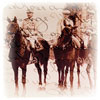Gunner Bertram Howard Cox was born in Barbados on December 13, 1894, to parents Charles Henry and Isabel Cox. He immigrated to Canada prior to the war and was working as a bank clerk in Winnipeg, Manitoba, at the time of his enlistment there with the 59th Overseas Battery, 15th Brigade, on March 26, 1916.
He shipped out to England in September 1916, where he was transferred to the 60th Battery, 14th Brigade C.F.A., and was sent over to France in August 1917. He remained with the 60th until the end of the war and was demobilized on June 28, 1919.
The collection consists of nearly forty letters written by Bertram to family and friends between 1916 to 1919. The majority are addressed to: his parents, his two brothers Carl (and wife Mabel) and Murrill (and wife Ella), and his sisters Ina and Leila (and husband Jack).
Also included is a transcription of the 1917 Christmas edition of the trench-newspaper The O’Pip, published “Somewhere in France” by the 58th Battery C.F.A. The paper was enclosed with a letter sent by Bertram to his sister Leila on January 11, 1918. (It has been posted below under the content category of “Newspaper Articles”)
External links:
Gunner Bertram Cox’s service record (Serv/Reg# 327964) can be viewed/downloaded in pdf format through Library and Archives Canada.
Please note: all letter transcriptions, including annotations to the letters, were provided by the donor.




